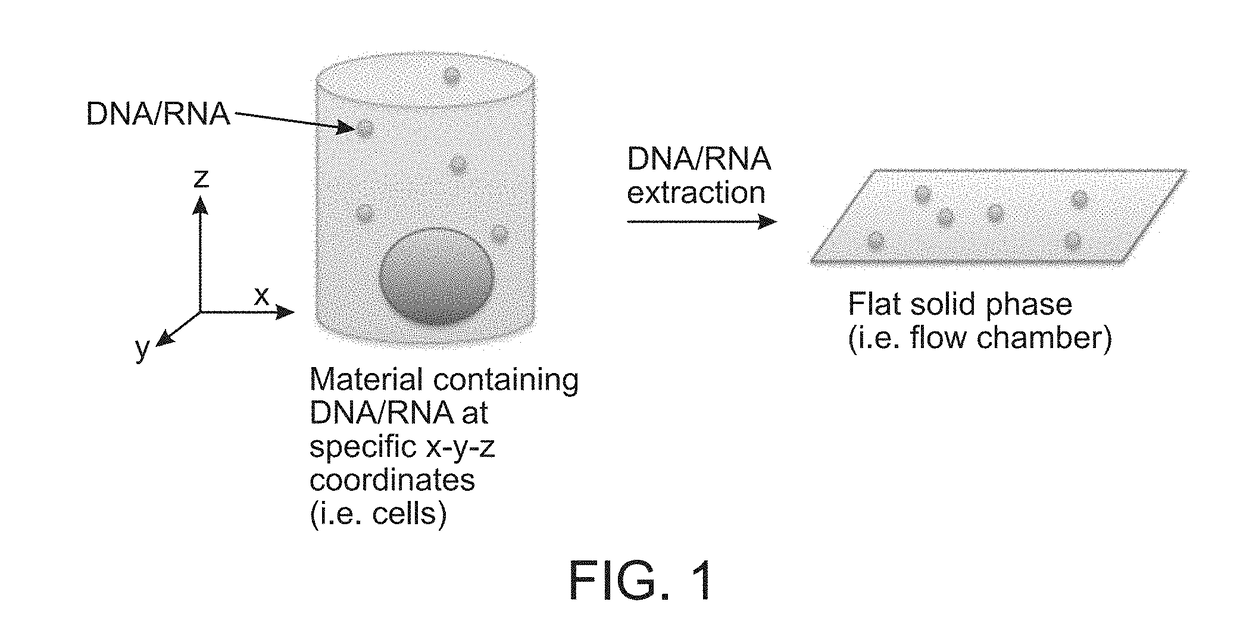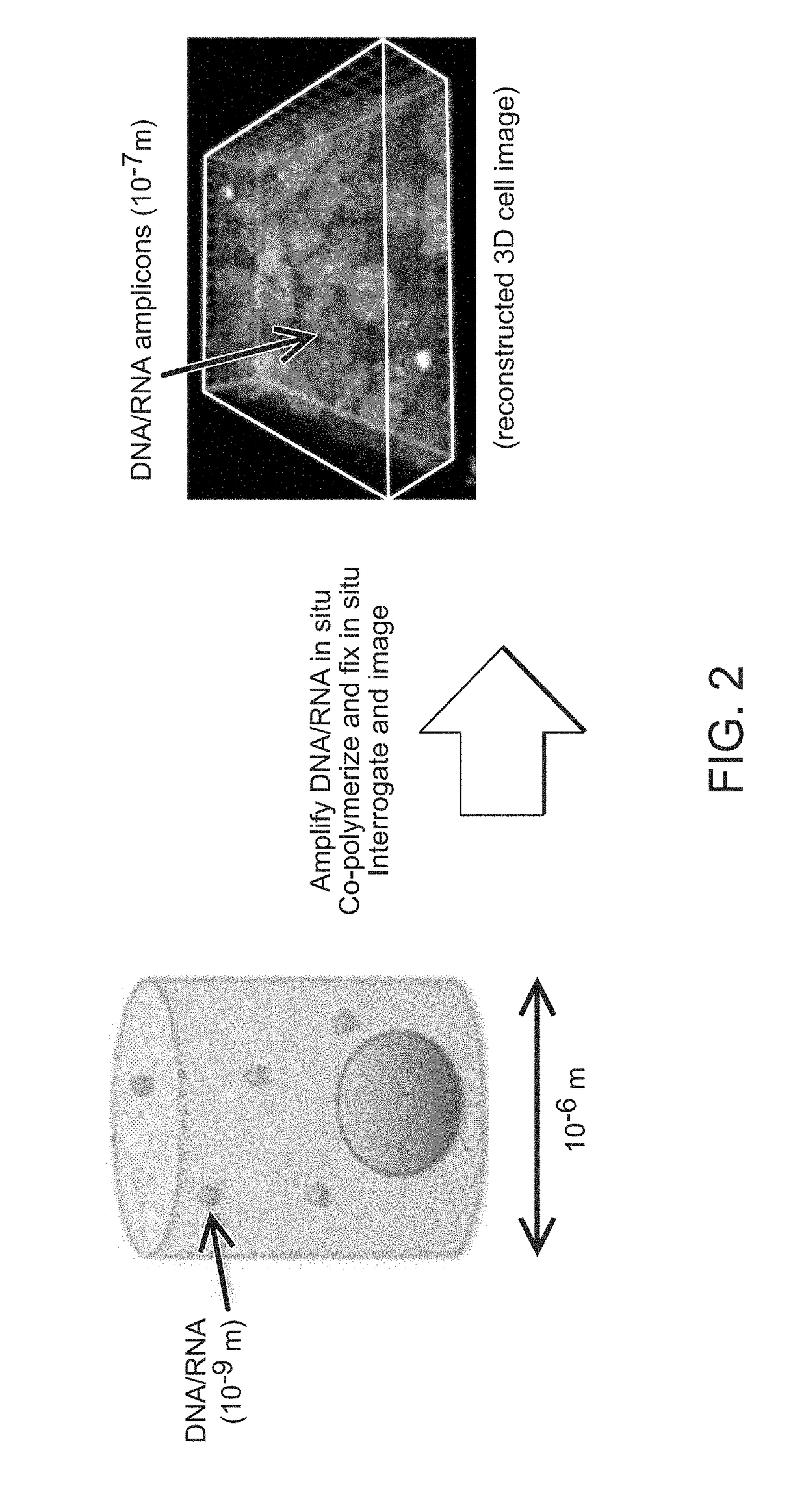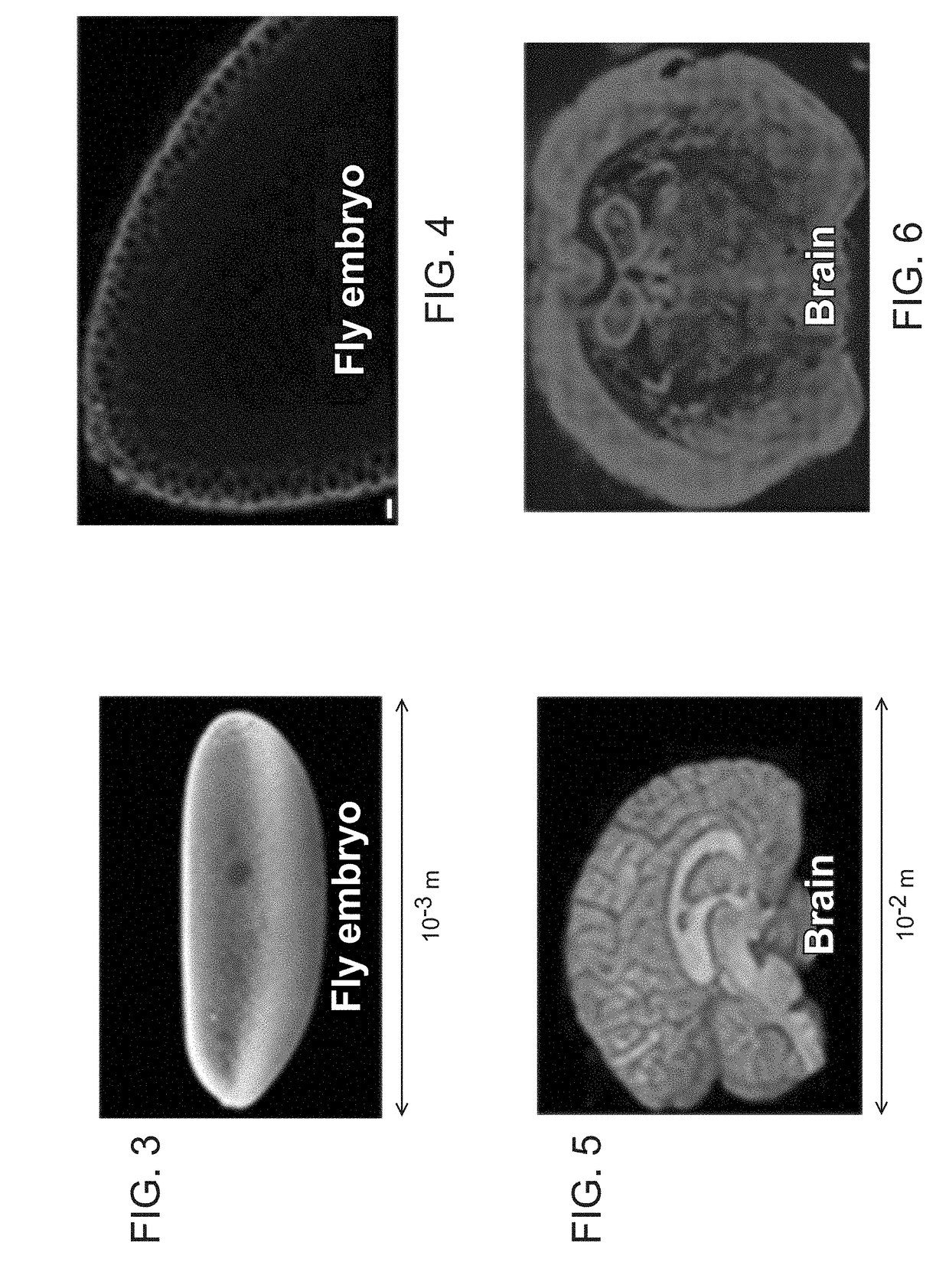Method for Generating A Three-Dimensional Nucleic Acid Containing Matrix
a three-dimensional nucleic acid and matrix technology, applied in the field of three-dimensional matrix of nucleic acids, can solve the problem of inability to identify the cellular origin of individual nucleic acids, and achieve the effect of high throughput sequencing and prolonged information storage and read-out cycles
- Summary
- Abstract
- Description
- Claims
- Application Information
AI Technical Summary
Benefits of technology
Problems solved by technology
Method used
Image
Examples
example i
Immobilizing, Amplifying and Imaging DNA / RNA Molecules Within Cells
[0068]Human iPS cells or human primary fibroblasts are grown on a 1.5 cover slip. They are fixed using 4% formaldehyde in PBS for 15 min, followed by three washes of 70% ethanol. The reverse transcription mixture containing 1 uM random hexamer or 0.1 uM polydT(18)V primer with additional adapter sequences (TCTCGGGAACGCTGAAGA), 250 uM dNTP, 40 uM aminoallyl dUTP (Anaspec), 20U RNase inhibitor and 100 U MMuLV reverse transcriptase (Enzymatics) are then added to the fixed cells and incubated overnight at 37° C. The sample is then washed using PBS, and cross-linked using 100 uM BS(PEG)9 (Thermo-Fisher Scientific) in PBS for 1 hour, followed by 1M Tris treatment for 15 min. The circularization mixture containing 25U CircLigase (Epicentre), 1 mM MnCl and 1 M Betain is added, and the sample is incubated at 60° C. for 2 hours. The residual RNA is degraded using a mixture of RNase cocktail (Roche) and RNase H (Enzymatics) at ...
example ii
Immobilizing, Amplifying and Imaging DNA / RNA Molecules Within a Fly Embryo
[0071]Drosophila embryos are fixed using 4% formaldehyde in PBS, followed by multiple washes of 70% ethanol. The embryos are then mounted on a cover glass using an optically transparent adhesive. The reverse transcription mixture containing 1 uM random hexamer or 0.1 uM polydT(18)V primer with additional adapter sequences (TCTCGGGAACGCTGAAGA), 250 uM dNTP, 40 uM aminoallyl dUTP (Anaspec), 20U RNase inhibitor and 100 U MMuLV reverse transcriptase (Enzymatics) are then added to the fixed cells and incubated overnight at 37° C. The sample is then washed using PBS, and cross-linked using 100 uM BS(PEG)9 (Thermo-Fisher Scientific) in PBS for 1 hour, followed by 1M Tris treatment for 15 min. The circularization mixture containing 25U CircLigase (Epicentre), 1 mM MnCl and 1 M Betain is added, and the sample is incubated at 60° C. for 2 hours. The residual RNA is degraded using a mixture of RNase cocktail (Roche) and ...
example iii
Immobilizing, Amplifying and Imaging DNA / RNA Molecules Within Mouse Brain
[0073]A fresh frozen adult mouse brain sections (20-um cryosections) are fixed using 4% formaldehyde in PBS. It is then treated with 0.4 ug / ml Proteinase K for 30 min at room temperature and thoroughly washed using 70%, 95% and 100% ethanol. The reverse transcription mixture containing 1 uM random hexamer or 0.1 uM polydT(18)V primer with additional adapter sequences (TCTCGGGAACGCTGAAGA), 250 uM dNTP, 40 uM aminoallyl dUTP (Anaspec), 20U RNase inhibitor and 100 U MMuLV reverse transcriptase (Enzymatics) are then added to the fixed cells and incubated overnight at 37° C. The sample is then washed using PBS, and cross-linked using 100 uM BS(PEG)9 (Thermo-Fisher Scientific) in PBS for 1 hour, followed by 1M Tris treatment for 15 min. The circularization mixture containing 25U CircLigase (Epicentre), 1 mM MnCl and 1 M Betain is added, and the sample is incubated at 60° C. for 2 hours. The residual RNA is degraded u...
PUM
| Property | Measurement | Unit |
|---|---|---|
| temperatures | aaaaa | aaaaa |
| temperatures | aaaaa | aaaaa |
| temperatures | aaaaa | aaaaa |
Abstract
Description
Claims
Application Information
 Login to View More
Login to View More - R&D
- Intellectual Property
- Life Sciences
- Materials
- Tech Scout
- Unparalleled Data Quality
- Higher Quality Content
- 60% Fewer Hallucinations
Browse by: Latest US Patents, China's latest patents, Technical Efficacy Thesaurus, Application Domain, Technology Topic, Popular Technical Reports.
© 2025 PatSnap. All rights reserved.Legal|Privacy policy|Modern Slavery Act Transparency Statement|Sitemap|About US| Contact US: help@patsnap.com



